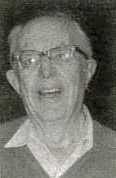


Obituary
Kenneth N. Trueblood (1920-1998)

Kenneth N. Trueblood, a leading scientist and teacher at UCLA for 49 years, died at home in Los Angeles on May 7, 1998. He was 78. The cause was cancer. Ken was unusual in excelling in all three areas of academic life: teaching, research, and administration. After joining the UCLA faculty in 1949 as a temporary instructor, he rose through the ranks, serving as Chair of Chemistry (1965-1970, 1990-1991), Dean of the College of Letters and Science (1971-1974), and Chair of the Academic Senate (1983-1984). Throughout this entire period, Ken continued the classroom teaching that he loved, and pursued his research on the three-dimensional structures of molecules, using x-ray diffraction. He was a pioneer in the use of computers to determine structures, and his work contributed to the Nobel prize discoveries of others, including his long-term collaborators Dorothy Hodgkin of Oxford and Donald Cram of UCLA. Ken remained active in research after retirement from the teaching faculty, completing the last of his 140 research papers just days before his death. In the early 1970's he organized a departmental X-ray crystallography lab used by organic and inorganic chemists, not crystallographers only, to so1ve chemical structural problems. This "departmental crystallographic lab" was a model copied by many chemistry departments throughout the world. Ken possessed a phenomenal memory for both chemicals and people. Upon running into former students who had been in one of his large classes years before, he would astound them by greeting them by name. His success in teaching and administration was rooted in his combination of modesty and interest in the well being of others that conveyed a feeling of integrity to all those who met him. He seemed always to see the best in others, and they responded to his expectations. Often he worked alongside his research students all night on the early computers to help solve crystal structure problems. Ken was a native of Dobbs Ferry, NY who studied chemistry at Harvard (A.B. 1941) and Caltech (Ph.D. 1947). Influenced by Linus Pauling, Ken became a crystallographer and set out on his life's work of determining the structures of molecules. For this he was honored with a Fulbright award for study at Oxford (1956-1957), a Guggenheim fellowship for research at the Swiss Federal Inst. of Technology (1976-1977), and the Fankuchen Memorial award of the American Crystallographic Assn (1995). He was elected President of the American Crystallographic Assn in 1961. He was visiting Professor at Ibadan, Nigeria (1964-1965) and visiting scientist at The Inst. of Elemento-Organic Compounds in Moscow, Russia (1965-1966). For his profound influence on beginning chemistry students, he received the first UCLA Distinguished Teaching award (1961) and the national award for excellence in teaching given by the Manufacturing Chemists Assn in 1978. Ken was coauthor of "Crystal Structure Analysis: Primer" (1972) and editor of "Dorothy Hodgkin and Linus Pauling - A Tribute" (1995). He was an avid fan of the New York Yankees and of all UCLA sports.
David Eisenberg, Jenny Glusker and Robert Sparks

